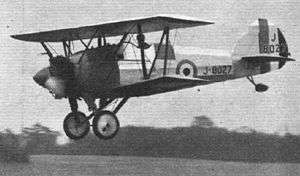Armstrong Whitworth Starling
The Armstrong Whitworth A.W.14 Starling was a British single-engine biplane fighter developed for the Royal Air Force in the 1920s. The plane was an unsuccessful model, with the Bristol Bulldog being selected instead.
| A.W.14 Starling | |
|---|---|
 | |
| Role | Fighter |
| Manufacturer | Armstrong Whitworth |
| First flight | 12 May 1927 |
| Status | Prototype only |
| Number built | 2 |
Development
The A.W.14 Starling was developed by Armstrong Whitworth to meet the requirements of Specification 28/24, for a single-seat fighter capable of operating in day and night-time conditions to replace Armstrong Whitworth's earlier Siskin. It was a single-bay sesquiplane (a biplane with the lower wing much smaller than the upper) with staggered unequal span wings. The fuselage had a bolted steel-tube structure, while the wings had steel spars and wooden ribs and were fitted with ailerons on the upper wings only. The wings used the experimental RAF 30 aerofoil section, which is symmetrical, with zero camber. Armament was two synchronised .303 in Vickers machine guns.[1][2][3]
Two prototypes were ordered, with the first J8027, powered by a 385 hp (287 kW) Armstrong Siddeley Jaguar VII radial engine flying on 12 May 1927.[2] It proved to be underpowered with this engine, and was therefore re-engined with a 460 hp (340 kW) Jaguar V engine. Performance was still unimpressive however, with the first prototype not exceeding speeds of 160 mph (260 km/h) rather than the expected 180 mph (290 km/h),[2] while low speed handling was poor.[4] The prototype was evaluated against the later Specification F.9/26 in February 1926, but was rejected by the RAF, who instead selected the Bristol Bulldog.[2] J8027 was returned to Armstrong Whitworth, who fitted it with new wings with Clark YH aerofoil section and leading edge slots fitted on the upper wings.[5] It was given the civil registration G-AAHC in May 1929, and was shown at Olympia in London in July 1929. It was cancelled from the register in December 1930.[6]
The second prototype, J8028 was heavily redesigned, with a more streamlined fuselage and revised wings, which although retaining the Clark YH aerofoil section, had smaller lower wings.[7] It was powered by a 525 hp (391 kW) Armstrong Siddeley Panther II engine, first flying on 5 December 1929.[2] It was evaluated as both a land-based interceptor against Specifications F.9/26 and F.20/27[8][9] and as a naval fighter to meet the requirements of Specification N.21/26. While showing better performance than the first prototype, it too was unsuccessful, although it did carry out useful development work for the Armstrong Whitworth A.W.16.[2]
Variants
- Starling I
- 1927 – first prototype – powered by Armstrong Siddeley Jaguar VII or V engine.
- Starling II
- 1930 – second prototype – specification N.21/26 for a naval fighter. Powered by Armstrong Siddeley Panther II engine.
Operators
Specifications (Starling I)

Data from The British Fighter since 1912 [2]
General characteristics
- Crew: 1
- Length: 25 ft 2 in (7.67 m)
- Wingspan: 31 ft 4 in (9.55 m)
- Height: 10 ft 6 in (3.20 m)
- Wing area: 246.4 sq ft (22.89 m2)
- Empty weight: 2,060 lb (934 kg) [10]
- Gross weight: 3,095 lb (1,404 kg)
- Powerplant: 1 × Armstrong Siddeley Jaguar V 14-cylinder air-cooled radial engine, 460 hp (340 kW)
Performance
- Maximum speed: 160 mph (260 km/h, 140 kn) at 10,000 ft (3,000 m)
- Service ceiling: 27,600 ft (8,400 m) [11]
- Time to altitude: 7 min to 10,000 ft (3,000 m)[11]
Armament
- Guns: 2 × 0.303 in (7.7 mm) Vickers machine guns
References
- Tapper 1988, pp. 168–170.
- Mason 1992, p. 189.
- Flight 2 August 1928, pp. 660–665.
- Tapper 1988, p. 170.
- Tapper 1988, pp. 170–171.
- Jackson 1974, p. 323.
- Tapper 1988, pp. 173, 175.
- Tapper 1988, p. 176.
- Williams Aeroplane Monthly July 1980, pp. 370–371.
- Green and Swanborough 1994, p. 27.
- Tapper 1988, p. 187.
- "The Armstrong Whitworth "Starling"". Flight. Vol. XX no. 31. 2 August 1928. pp. 660–665.
- Green, William; Swanborough, Gordon (1994). The Complete Book of Fighters. New York: Smithmark. ISBN 0-8317-3939-8.
- Jackson, A. J. (1974). British Civil Aircraft since 1919 Volume I. London: Putnam. ISBN 0-370-10006-9.
- Mason, Francis K. (1992). The British Fighter since 1912. Annapolis, Maryland, USA: Naval Institute Press. ISBN 1-55750-082-7.
- Tapper, Oliver (1988). Armstrong Whitworth Aircraft since 1913. London: Putnam. ISBN 0-85177-826-7.
- Williams, Ray (July 1980). "Siskin Successor". Aeroplane Monthly. Vol. 8 no. 7. pp. 368–371.
External links
| Wikimedia Commons has media related to Armstrong Whitworth Starling. |